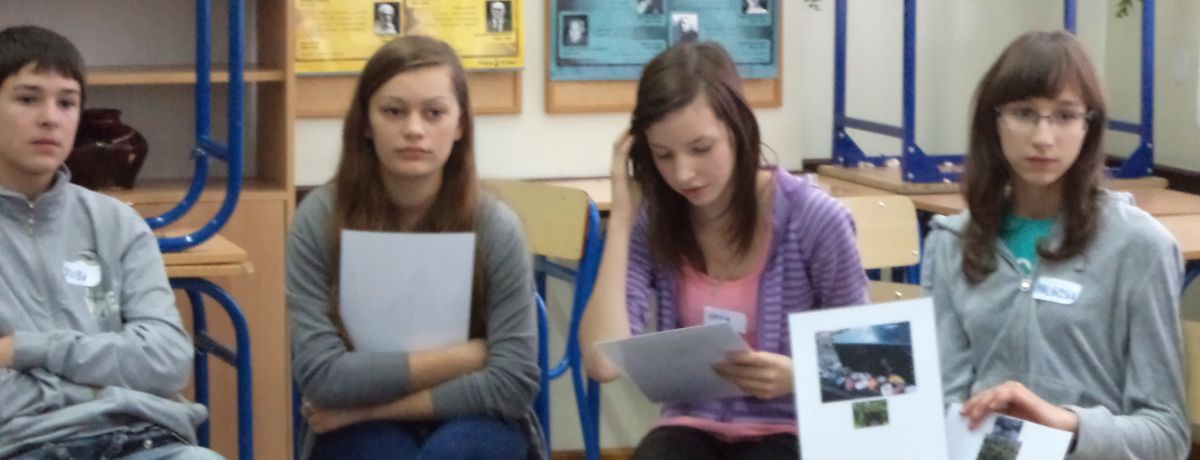| 2011 |
Szydłów
The School of Dialogue in W.S.Reymont Public High School


| 2011 |
Szydłów is a walled village in the Świętokrzyskie voivodship. Its defensive, medieval walls are longer than in Cracow and are very well preserved. The village could be the Polish Carcassonne. The Festival of Jewish Culture, has been held for 13 years now. Jews lived in Szydłów from the 15th century, being from a third to a half of its inhabitants. They were mostly traders, and there was a synagogue, a cemetery, a cheder, a mikveh and Jewish butchers’. In January 1942 a ghetto was created, but it lasted only three months, as in April all Jews from the Szydłów ghetto were transported to the Jędrzejów ghetto, and then to the death camp in Treblinka. Today the main memento of Jewish presence in Szydłów is the 16th-century synagogue, currently housing the Cultural Center and an exhibition of Jewish artefacts.
Because of the Festival the Szydłów students are no strangers to Jewish culture or religion. During the the School of Dialogue workshops, however, their knowledge was enhanced and deepened. “We learnt a lot about Jews living in our village, thanks to the workshops” – says one of the students from the School of Dialogue.
When preparing the tour “Following the footsteps of Szydłów Jews” the students used various sources: talked with eldest members of their families, teachers and Szydłow inhabitants, browsed internet pages and books on local history. As the educators running the workshops observed, they were extremely determined to find Jewish traces in Szydłów. They located the places where the mikvah, the butcher’s and the baker’s were located. During the meeting with the municipality head, Jan Klamczyński, they learnt about the initiatives to promote the Jewish heritage on the municipal level.
Some students got particularly interested in the area. They have no trouble visualising the everyday life in pre-war Szydłów: “An ironmonger’s was owned by a Jew, Zalcman. It was located next to the present municipality building. There was the second ironmonger’s nearby. Next to the synagogue a cap maker lived. A Jewish leather worker had his workshop near the market square, in a place we were unable to determine. Then the cordwainer used the leather to make shoes.
Next to the Cracow Gate there was a Jewish butcher, Zaumme” – this is a description of a pre-war Szydłów by a workshop participant.
The students invited their teachers to participate in the tour. “There are numerous monuments associated with Jewish culture in Szydłów – pre-war houses, the oldest synagogue in Poland, remains of a Jewish cemetery and baths. There are places where the rabbi’s house stood, and the butcher’s. The Jewish traces walk is really an interesting tour !” – this is how the tour was advertised by Małgosia. The first item of the itinerary was the synagogue, today the Cultural Centre, a huge stone building with massive buttresses, a relic of the defensive character of the city. Inside there are many religious objects, and yet it looks empty, as there are no polychrome frescoes on the walls, destroyed in a fire, or a bimah, vandalized during the war. The students tell the story of the building and about its importance to the Jews.
The next stop in Opatowska Street, where before the war there were butchers’ and a market. “Market stalls, owned by Jews and Poles alike, offered vegetables, fruits, artisan products, fabrics, wools, cows, horses, sheep, goats, chickens and pigeons” – a student narrates. The trip participants learn about the shechita and move to the place where the mikvah used to be. Like the last stop – the cemetery – it is a sad one, as no trace of either remains. Second World War destroyed both and now there are meadows. Surviving tombstones are stored in the synagogue.
The trip ends with hot tea and some matzo. The students are glad they could have passed their knowledge onto others. The Jewish history of Szydłów became tangible for them, just like the curtain walls around the village. A participant said then, about the former Jewish inhabitants of the village: “I wonder how it would be if they lived next to us. I will probably never know. All that is left is to cherish what we know and propagate it”.

School:
W. S.Reymont Public Junior High School
Students:
2nd year students
Teachers:
Dorota Kowalczewska-Spetel
Expert:
Jan Klamczyński
Educators:
Małgorzata Nowicka, Marta Usiekniewicz
School of Dialogue program in Szydłów was made possible by the support from PIOTR LEWICKI, PAWEŁ CIACEK and RAFAŁ KOS.
In appreciation to Friends of the Forum for supporting the School of Dialogue educational program.
